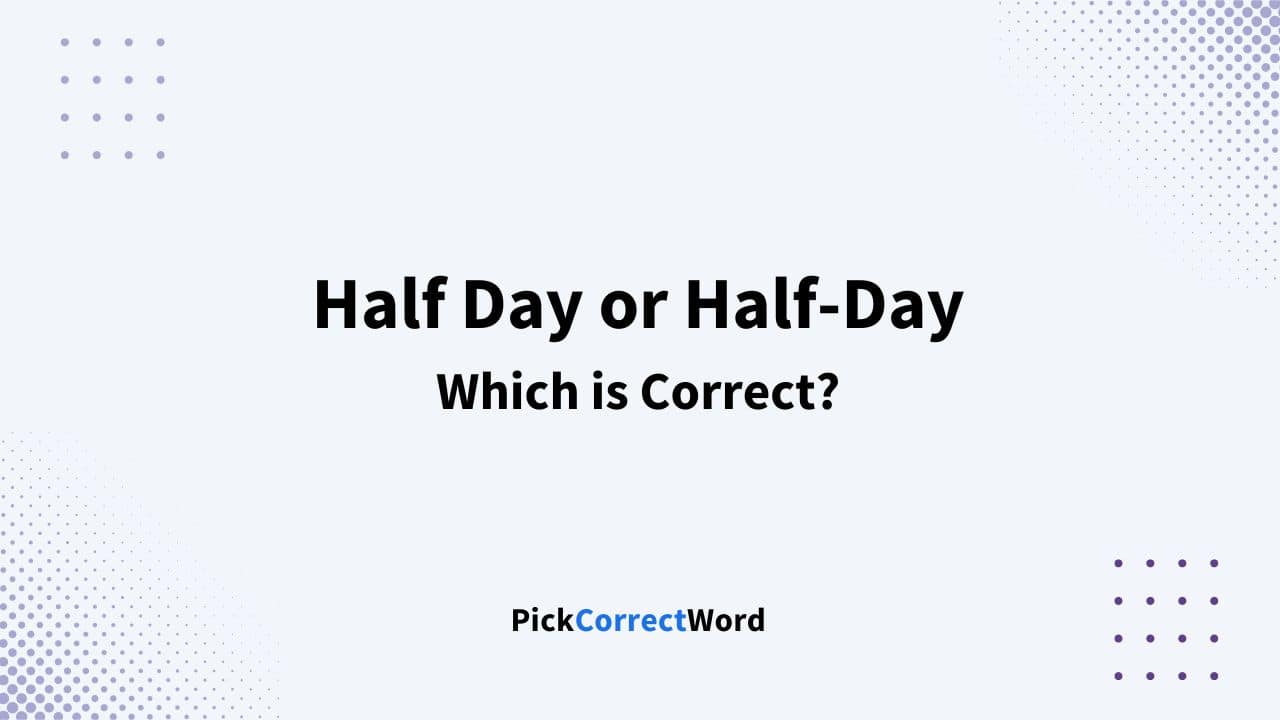Ever found yourself writing an email or a report and got stuck deciding between ‘half day’ or ‘half-day’? Actually, both are correct, but they’re used differently.
Consider ‘half day’ (without the hyphen) as a noun. It refers to when you work or go to school for only part of the day.
But ‘half-day’ (with the hyphen) is an adjective that describes something else that only lasts for half the usual time. For example, a ‘half-day meeting’.
Half Day or Half-Day? Which is Correct?
Both ‘half day’ and ‘half-day’ are correct, but they’re used in different situations.
“Half day” without a hyphen is a noun that means a day is only a part of the usual working hours. When you add a hyphen to make “half-day,” it turns into an adjective that describes something that lasts for half a day.
Examples of Each
- As a Noun (No Hyphen):
- You might take a half day off from work to attend a personal event.
- As an Adjective (With Hyphen):
- Your company might offer a half-day training session for new employees.
Half Day: Meaning and Usage
“Half day” simply means a time span that is about half of a regular workday. It’s a term often used when talking about your work hours, a training session, or clinic timings. It might refer to either the morning or afternoon part of a workday.
As a noun, ‘half day’ denotes a period of time rather than describing a feature of another noun. How you understand its meaning often depends on the situation in which it’s used.
Without the hyphen, you might say:
- “I have a half day on Friday to complete the care assessment.”
Remember, ‘half day’ is a noun. Recognizing this can help you build your sentences correctly and make what you’re saying clearer.
Half-Day: Meaning and Usage
The term ‘half-day’, when used with a hyphen, works as an adjective in English. It’s used to explain that something else only lasts for half of the usual time. It’s not about a specific time period itself.
This is where the hyphen plays an important role. It transforms ‘half day’ from a noun to an adjective that modifies another noun.
For example:
“It was a half-day meeting”,
Here, the phrase ‘half-day’ describes the noun ‘meeting’, indicating it will only last for half the usual workday.
Examples of Using “Half Day“ in A Sentence
“I’m taking a half day off tomorrow to visit the doctor.”
“The school has declared a half day for students due to the sports event.”
“He took a half day to attend his son’s graduation ceremony.”
“Our company provides a half day on Fridays for work-life balance.”
“She decided to take a half day to finish her project at home.”
Examples of Using “Half-Day“ in A Sentence
“We have a half-day workshop scheduled for new recruits.”
“I attended a half-day seminar on digital marketing.”
“The half-day training session was very informative.”
“The company arranged a half-day team building activity for its employees.”
“The school is organizing a half-day field trip for the students.”
Frequently Asked Questions
What is the plural of half-day?
The plural of “half-day” is “half-days” when referring to multiple days consisting of a half day schedule. For example, you might say, “The conference has two half-days of workshops.”
How should ‘half day’ be hyphenated in formal writing?
In formal writing, “half day” should be hyphenated to “half-day” when used as an adjective before a noun, such as “half-day meeting.” When used as a noun, it is typically written without a hyphen even in formal contexts.
What are the typical starting or ending times associated with a half day?
A half day often refers to either the first or second half of the workday. This generally translates to a starting time of the morning, often 8 or 9 AM, and an ending time around 12 or 1 PM for morning half-days, or starting early afternoon and ending at the close of business hours for afternoon half-days.


